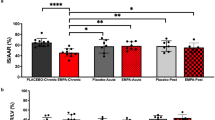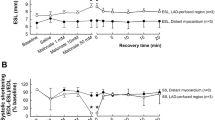Summary
Potential protective effects of oxfenicine [(S)-4-hydroxyphenylglycine] in ischemic stressed canine myocardium have been studied. This compound is characterized as a drug leading to metabolic inhibition of free fatty acid (FFA) metabolism.
The drug (0.06 mmol·kg−1 body weight) caused no changes in hemodynamics or energy demand (Et) but depressed myocardial oxygen consumption (MVO2) by 11% (P<0.02). Significant changes in FFA and lactate metabolism were observed: lactate extraction (EX) increased from 22.5–37.1 μmol/min, extraction ratio (EXR) from 16.5–30% and oxygen extraction ratio (OER) from 24.8–38%; EX of FFA decreased from 6900–5000 nmol/min, EXR from 48.2–31.4% and OER from 59.7–46.6%. Arterial concentrations of FFA and lactate remained unchanged. EX, EXR and OER of glucose were not affected under basic conditions.
In the same collective, repeated ischemia (3 min) was produced by proximal occlusion of the left anterior descending artery (LAD). The efficiency of the drug was examined by (a) the amounts of ischemia metabolites released in the early reperfusion and (b) quantification of O2-debt and O2-repayment in the occlusion- and reperfusion periods. Compared to control occlusions, premedication led to a reduced O2-debt (P<0.01) combined with a reduced amount of oxygen additionally taken up in the early reperfusion (P<0.05). Furthermore, release of potassium increased (+7.1%; P<0.05); release of lactate (-32%, P<0.001) and inorganic phosphate (-34%, P<0.01) decreased.
These data give support to the concept that a pharmacologically induced shift of cardiac metabolism with reduction of FFA utilisation may be favourable in circumstances with limited oxygen supply.
Similar content being viewed by others
References
Baller D, Bretschneider HJ, Hellige G (1979) Validity of myocardial oxygen consumption parameters. Clin Cardiol 2:317–327
Bergman C, Atkinson L, Metcalfe JM, Jackson N, Jewitt DE (1979) Potential protective value of enhanced myocardial carbohydrate utilization with reduced free fatty acid uptake after UK 25842 in patients with coronary artery disease. Br Heart J 42:240 (Abstr)
Bergmeyer HU (1974) Methoden der enzymatischen Analyse. Hans Ulrich Bergmeyer. Verlag Chemie, Weinheim/Bergstraße
Blackburn KJ, Burges RA, Gardiner DG, Higgins AJ, Morville M, Page MG (1979) Protection against experimental myocardial ischaemia by L-4-hydroxy-phenylglycine, a new agent which alters myocardial balance in favour of carbohydrate utilization. Br J Pharmacol 66:443 (Abstr)
Challoner DR, Steinberg D (1966) Effect of free fatty acid on the oxygen consumption of perfused rat heart. Am J Physiol 210 (2):280–286
Darsee JR, Kloner RA (1981) Dependency of location of salvageable myocardium on type of intervention. Am J Cardiol 48:702–710
De Leiris J, Opie LH, Lubbe WF (1975) Effects of free fatty acid and glucose on enzyme release in experimental myocardial infarction. Nature 253:746–747
Folch J, Lees M, Stanley GHS (1957) A simple method for the isolation and purification of total lipids from animal tissues. J Biol Chem 226:497–510
Gupta DK, Young R, Jewitt DE, Hartog M, Opie LH (1969) Increased plasma-free-fatty-acid concentrations and their significance in patients with acute myocardial infarction. Lancet 2:1209–1213
Henderson AH, Most A, Parmley WW, Gorlin R, Sonnenblick EH (1970) Depression of myocardial contractility in rats by free fatty acids during hypoxia. Circ Res 26:439–449
Higgins AJ, Morville M, Burges RA, Gardiner DG, Page MG, Blackburn KJ (1980) Oxfenicine diverts rat muscle metabolism from fatty acid to carbohydrate oxidation and protects the ischemic rat heart. Life Sci 27:963–970
Higgins AJ, Morville M, Burges RA, Blackburne KJ (1981) Mechanism of action of oxfenicine on muscle metabolism. Biochem Biophys Res Comm 100:291–296
Hoeft A, Korb H, Baller D, Wolpers HG, Hellige G, Bretschneider HJ (1984) Quantification of ischemic stress during repeated coronary artery occlusion in the dog. A method for validation of therapeutic effects. I. Estimation of O2-debt and O2-repayment. Basic Res Cardiol 79:27–37
Kahles H, Mezger VA, Hellige G, Spieckermann PG, Bretschneider HJ (1982a) The influence of myocardial edema formation on the energy consumption of the heart during aerobiosis and hypoxia. Basic Res Cardiol 77:158–163
Kahles H, Hellige G, Hunneman DH, Mezger VA, Bretschneider HJ (1982b) Influence of myocardial substrate utilization on the oxygen consumption of the heart. Clin Cardiol 5:286–293
Kaijser L, Berglund B, Carlson LA (1979) Effect of pyruvate dehydrogenase activation on myocardial substrate metabolism in healthy men. Eur J Clin Invest 9:18 (Abstr)
Korb H, Hoeft A, Baller D, Wolpers HG, Hellige G, Bretschneider HJ (1984) Quantification of ischemic stress during repeated coronary artery occlusion in the dog. A method for validation of therapeutic effects. II. Reproducibility of the release and uptake of electrolyte and substrates. Basic Res Cardiol 79:38–48
Medical Research Council (1968) Clinical trial of potassium-glucose-insulin treatment in acute myocardial infarction. Lancet 2:1355–1360
Mjøs OD (1971) Effect of free fatty acids on myocardial function and oxygen consumption in intact dogs. J Clin Invest 50:1386–1389
Neely JR, Whitmer JT, Rovetto MJ (1975) Effect of coronary blood flow on glycolytic flux and intracellular pH in isolated rat hearts. Circ Res 37:733–741
Opie LH (1970a) The glucose hypothesis: Relation to acute myocardial ischaemia. J Mol Cell Cardiol 1:107–115
Opie LH (1970b) Effect of fatty acids on contractility and rhythm of the heart. Nature 227:1055–1056
Severeid I, Connor W, Long JP (1969) The depressant effect of fatty acids on the isolated rabbit heart. Proc Soc Exp Biol 131:1239–1243
Sigmund-Duchanova H, Baller D, Bretschneider HJ, Prennschuetz-Schuetzenau H, Piesker KH, Vennebusch H, Zipfel J, Hellige G (1979) Experimental validation of methods for the measurement of coronary sinus blood flow in man. Basic Res Cardiol 74:277–287
Sodi-Pallares D, Testelli MR, Fishleder BL et al. (1962) Effects of an intravenous infusion of a potassium-glucose-insulin solution on the electrocardiographic signs of myocardial infarction. A preliminary clinical report. Am J Physiol 9:166–181
Vik-Mo H, Mjøs OD (1981) Influence of free fatty acids on myocardial oxygen consumption and ischemic injury. Am J Cardiol 48:361–365
Waldenstroem A, Hjalmarson A (1980) Effects of pyruvate dehydrogenase activation on myocardial tolerance to ischemia. J Mol Cell Cardiol 12 (Suppl 1): 176 (Abstr)
Author information
Authors and Affiliations
Rights and permissions
About this article
Cite this article
Korb, H., Hoeft, A., Hunneman, D.H. et al. Changes in myocardial substrate utilisation and protection of ischemic stressed myocardium by oxfenicine [(S)-4-hydroxyphenylglycine]. Naunyn-Schmiedeberg's Arch. Pharmacol. 327, 70–74 (1984). https://doi.org/10.1007/BF00504994
Received:
Accepted:
Issue Date:
DOI: https://doi.org/10.1007/BF00504994




